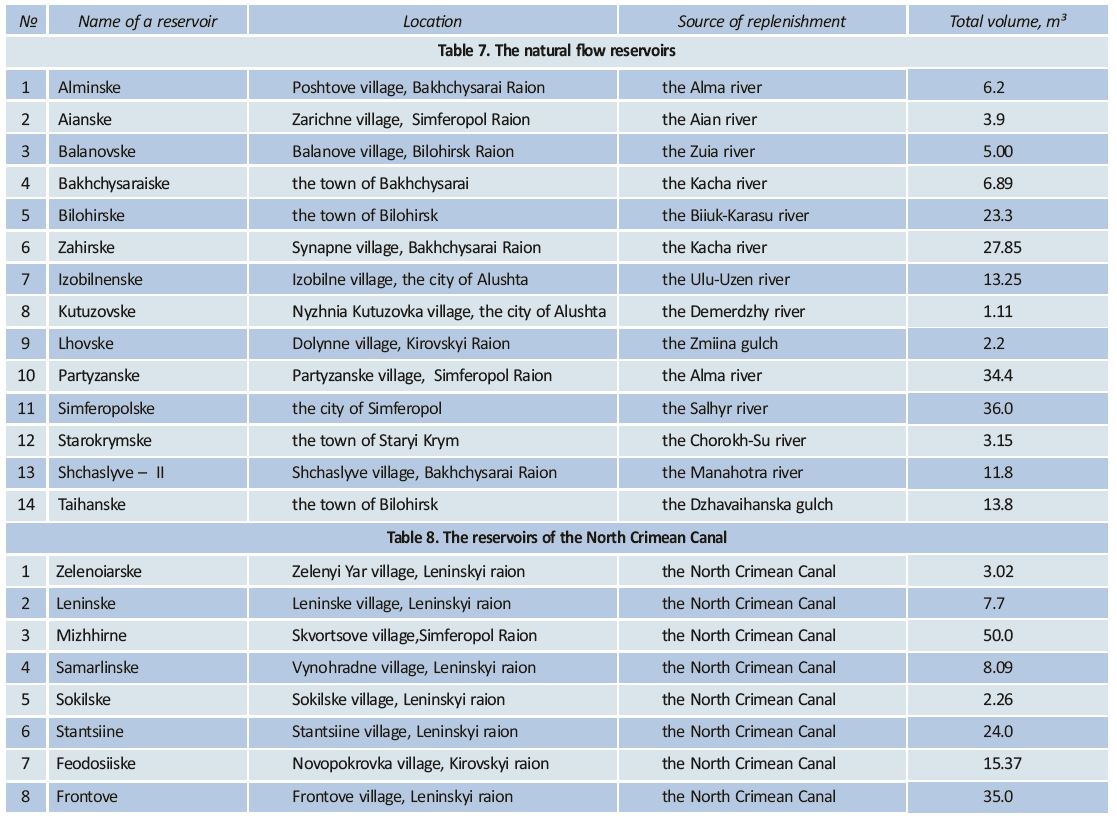Water in Occupied Crimea / 2014-2021
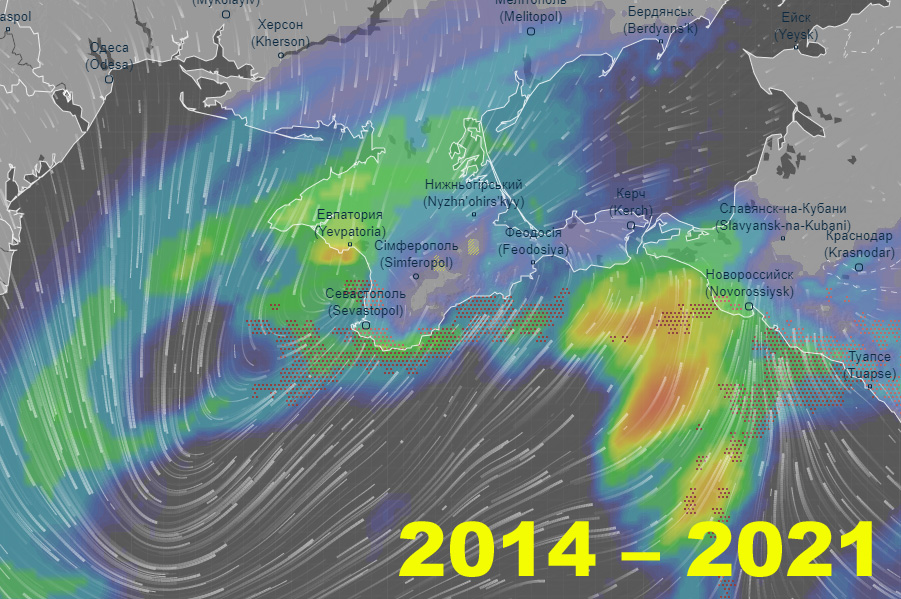
The Monitoring Group of BlackSeaNews
and the Black Sea Institute of Strategic Studies
presents an updated series of articles
«The Socio-Economic Situation in Occupied Crimea in 2014 – 2021»:
Back in the USSR. The Reverse Restructuring of the Crimean Economy / 2014-2021
The "Trophy Economy". Militarization as a Factor of Industrial Growth / 2014-2021
The "Trophy Economy". The Development of the Stolen Ukrainian Black Sea Shelf / 2014-2021
The Crimean "Trophy Economy": The Sale of Ukrainian Property. An Updated Review for 2014 – 2021
The Occupied Crimean Tourism / 2014-2021
Occupied Crimea. Exports and Imports / 2014-2021
The Banking System of Crimea: What is Really Happening on the Occupied Peninsula (Updated)
Investment. What the "Crimean" Federal Target Programme Finances / 2014-2021
«Migration weapons»: the replacement of the Crimean population with Russian
Water in Occupied Crimea / 2014-2021
The Crimean Budget. Small Business. Salaries and Pensions / 2014-2021
* * *
Since the spring of 2020, the information space has been stirred by the situation with water supply to the occupied Crimean Peninsula.
For this reason, we will remind our readers of some basic facts.
1. The fact that most of the Crimean Peninsula is the steppes characterized by long, dry, and very hot summers and snowless winters is not news. The island configuration exacerbates this situation (it can be seen on precipitation maps very clearly). Climate change in the 21st century will continue to make the Crimean climate harsher.
2. It is also well known that since 1971, when the North Crimean Canal reached Kerch, the Dnieper water had provided 85% of water consumption in Crimea. They were well aware of this fact in Russia when they decided to occupy the peninsula in 2014.
3. Cuttng off the water supply to the occupied peninsula in April 2014, or the so-called "water blockade", is a type of economic sanctions imposed in response to the occupation and illegal annexation not recognized by the whole world. Or, to be more precise, the "water blockade of Crimea" is one of the main elements of Ukraine's economic war against Russia.
The sanctions regime as a whole and the water blockade as one of its most effective components aim to increase the price paid by Russia for its aggressive actions, and in the long run, along with other sanctions, to force Russia to end the occupation.
4. It so happened that the years of the occupation until 2020 in Crimea were marked by an unusually high level of precipitation. But it could not last forever.
There are 22 large reservoirs in Crimea with a total volume of 399.4 million cubic metres. Depending on the recharge source, they are divided into:
- natural flow reservoirs – there are 14 of them in Crimea and 1, the Chornorichenske reservoir, in Sevastopol. Their volume is 188.85 + 64.2 = 252.7 million cubic metres. They are recharged during the autumn-winter period, spring floods, and sometimes in the summer during showers;
- off-stream reservoirs of the North Crimean Canal. There are 8 of them and their volume is 146.35 million cubic metres.
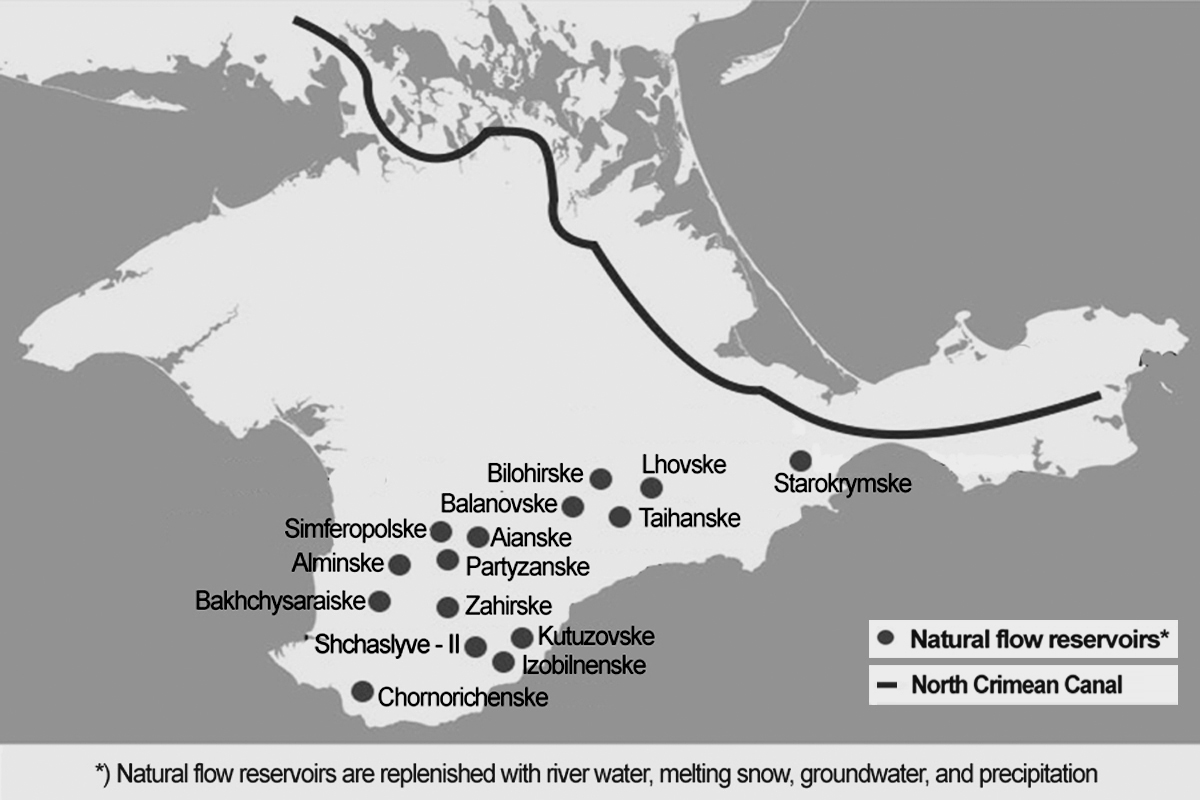
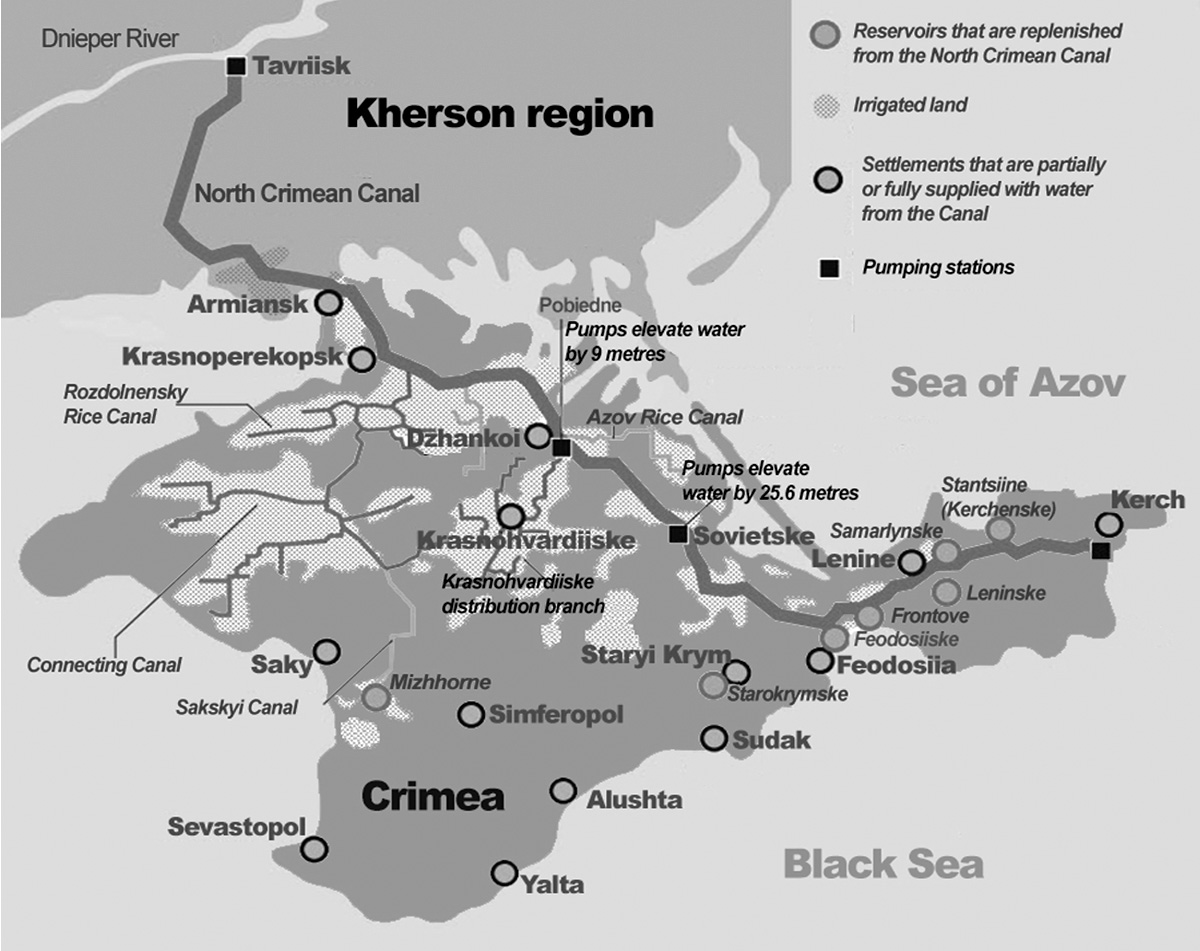
According to the Representative Office of the President of Ukraine in the Autonomous Republic of Crimea and the State Agency of Water Resources of Ukraine, in the decade until 2014, the North Crimean Canal annually supplied more than 1 billion cubic metres of the Dnieper water to the Crimean Peninsula, which accounted for up to 85% of total water consumption in the Autonomous Republic of Crimea.
In 2013, 1.134 billion cubic metres of water was supplied to the Autonomous Republic of Crimea via the North Crimean Canal, including for the needs of:
-
irrigation – 952 million cubic metres (83.95% of the water supply to Crimea);
-
household needs of the population (filling the reservoirs) – 103 million cubic metres (9.08%);
-
fisheries – 19 million cubic metres (1.68%);
-
other needs – 60 million cubic metres (5.29%).
That is, the needs of the agro-industrial and industrial sectors of the Autonomous Republic of Crimea accounted for the largest share of water from the North Crimean Canal.
The local water resources of Crimea are on average approximately 915 million cubic metres per year, decreasing in particularly dry years to 430 million cubic metres. This figure consists of groundwater reserves of 445.5 million cubic metres per year, 14 natural flow reservoirs and 1994 man-made ponds with a total usable storage of 470.7 million cubic metres per year.
According to the data of the state records of water use, about 101-105 million cubic metres of water was used annually for drinking and household needs in the Autonomous Republic of Crimea, which is approximately 9 times less than the total local flow and projected groundwater reserves and 4 times less than those in dry years. Before the occupation, when the population of the peninsula was 1,967,200 people, the average per capita consumption of water in Crimea was 53.4 cubic metres per year.
Let us take a look at some unrealistically inflated figures.
According to Russian building codes, the standard water consumption per person in apartment blocks more than 12 floors high with a centralized hot water supply and increased requirements for providing amenities is 400 litres per day (146 cubic metres per year). If we imagine that all the 3 million people, which constitute the peninsula's de facto population, live in flats in high-rise buildings, the standard volume of water consumption is 3 million people x 400 litres x 365 days = 438 million cubic metres. Even such volumes are covered by Crimea's own water resources available in dry years (430 million cubic metres).
That is, the shortage of water for the population of Crimea has been caused not only by an increase in the de facto population during the occupation years by 0.8-1.0 million people and large-scale housing construction for the "new population" but, above all, by a significant increase in water consumption by military units and military plants and clearly insufficient maintenance of water supply networks (in the hope that it will be possible to force Ukraine to reopen the North Crimean Canal).
According to our information, as early as April 2020, the Ministry of Natural Resources and Ecology of the Russian Federation sent an instruction to the so-called "Minister of Ecology and Natural Resources of the Republic of Crimea" to report on the current level of water storage, rates of water withdrawal, and prospects for the replenishment of water resources during the summer of 2020.
Increased attention of the federal centre to the problem of water supply to Crimea was caused by a number of enquiries of the State Duma of the Russian Federation deputies on existing mechanisms to address the problem of water shortage on the peninsula, which led to a sharp decrease in sown area and falling yields in 2019.
According to the report by the leadership of the so-called "Crimean State Committee on Water Management and Land Reclamation", which was prepared in May 2020,
-
"…water storage in natural flow reservoirs had not been replenished since the end of March 2020 due to the prolonged drought."
-
The total water storage in the Crimean reservoirs as of 30 April was 90 million cubic metres (13 million less than at the beginning of April). It is worth reminding that the total volume of the reservoirs is 399.4 million cubic metres.
-
The Simferopolske reservoir was 20% full, in April only 600 thousand cubic metres of water was received ... The available volume allowed for providing for the needs of the capital of Crimea for no more than 4 days.
-
The Aianske Reservoir, which provides Simferopol and the settlements of the Salhyr valley with water, was filled to 60% of its capacity (due to melting snow in the mountains) and remained the main source of water supply to Simferopol. Available storage would suffice for 2-3 months, the recharge rate was declining due to the end of the snow-melt season and the absence of precipitation.
-
The Bilohirske and Taihanske reservoirs, which were previously used to provide water for agriculture in the eastern Crimea, were at that time only supplying water for the needs of the population of the north-eastern Crimea. They were not more than 30% full; with the withdrawal rate existing at that time, the storage would suffice for 2 months.
-
The Partyzanske reservoir (provides for the needs of Simferopol, its western suburbs, and rural settlements of the district) was filled only to 30% of its capacity, its recharge rate did not exceed 10% of the average annual rate. The storage would suffice for 3-4 weeks.
-
In May 2020, the situation with water supply looked the least threatening in the reservoirs that provided water for the settlements of Greater Yalta and the city of Alushta. The Zahirske and Shchaslyvenske reservoirs were 60% full, Izobilnenske (Alushta) was 70% full...".
According to Crimean officials, solving the problem of water supply in Crimea relying on local forces is not possible.
They mean that there is no funding, expert opinions, and completed design work for numerous desalination projects and using deep aquifers, as a result of which even the funds allocated for these purposes by the government of the Russian Federation within the Federal Target Programme have not been used.
Local collaborators consider "a solution to the problem in the political sphere, at the level of the leadership of Russia and Ukraine" to be the only possible way to ensure adequate water supply to the population and economy of Crimea.
Based on these data, as early as late May 2020, the authors predicted that in the summer of 2020, the situation would be similar to the one that existed in Crimea until 1971, where running water, except for Yalta and Alushta, would be available for only a few hours a day, and in summer – maybe not every day. No catastrophe – just a 50-year step backwards.
That's exactly what happened. In 2020, water supply schedules were introduced in Crimea, sometimes very strict: 2 hours in the morning and 2 hours in the evening.
Overall, the occupation authorities' underestimation of the urgent annual needs for the maintenance and reconstruction of water supply networks in the climatic conditions of Crimea has led to the situation where the water problem has become one of the most important factors hindering further population replacement, industrial development, tourism, and investment.
In 2021, the situation with the water supply to Crimea has improved due to increased precipitation. However, this has not led to a lasting solution to the problem. Dependence on climatic conditions remains a major risk factor.
At the same time, the Russian government has allocated significant funds for the reconstruction of water supply systems on the peninsula. This decision indirectly confirms that in modern conditions, the main factor that further exacerbates the problem of drinking water in Crimea is the insufficient maintenance of water supply networks.
Russia's decision to finally renovate the water supply networks on the occupied peninsula was also a consequence of the fact that in early 2021, Ukraine, for the first time at the level of state documents, recorded its position on restoring water supply to Crimea through the North Crimean Canal.
On 24 March 2021, the President of Ukraine, by his Decree, put into effect the decision of the National Security and Defence Council of Ukraine of 11 March 2021 On the strategy of de-occupation and reintegration of the temporarily occupied territory of the Autonomous Republic of Crimea and the city of Sevastopol. Paragraph 66 of this document states: "Ukraine ensures the creation of conditions for providing water supply to the Crimean Peninsula after the liberation of the temporarily occupied territory and the restoration of the constitutional order of Ukraine on this territory."
At the same time, the risks of a possible military special operation of the Russian Federation on the territory of the Kherson region, which borders Crimea and where the North Crimean Canal begins, remain.
* * *
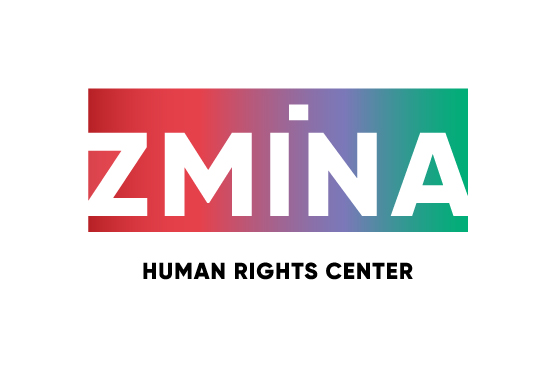
This article has been published with the support of ZMINA
Human Rights Centre.
The content of the article is the sole responsibility of the authors.
More on the topic
- 21.08.2023 Peculiarities of the 2023 Crimean Holiday Season — a «Tourism» in Camouflage
- 06.08.2023 Crimea During the Great War. Part 2. Extreme Tourism or «New Types of Tourism» and Tourist Numbers (2)
- 21.07.2023 Crimean Titan: Under a Russian Holding or a Ukrainian Tank?
- 12.06.2023 Crimea during the Great War. The situation in the occupied Crimea in 2022-2023. Military Context (1)
- 23.11.2021 Occupied Crimea. Exports and Imports / 2014-2021
- 23.11.2021 The Crimean Budget. Small Business. Salaries and Pensions / 2014-2021
- 23.11.2021 The "Trophy Economy". The Commercial Exploitation of Marine Biological Resources in the Black Sea and the Sea of Azov / 2014–2021
- 21.11.2021 The "Trophy Economy". Militarization as a Factor of Industrial Growth / 2014-2021
- 21.11.2021 Back in the USSR. The Reverse Restructuring of the Crimean Economy / 2014-2021
- 20.11.2021 The "Trophy Economy". The Development of the Stolen Ukrainian Black Sea Shelf / 2014-2021
- 20.11.2021 The Occupied Crimean Tourism / 2014-2021
- 20.11.2021 Investment. What the "Crimean" Federal Target Programme Finances / 2014-2021
